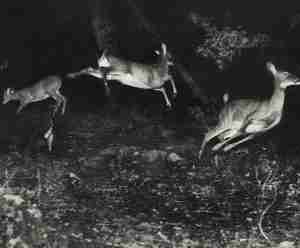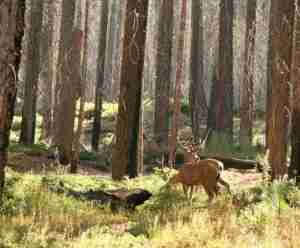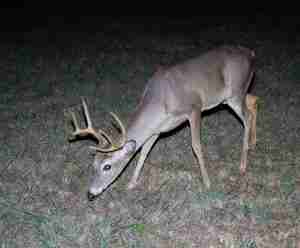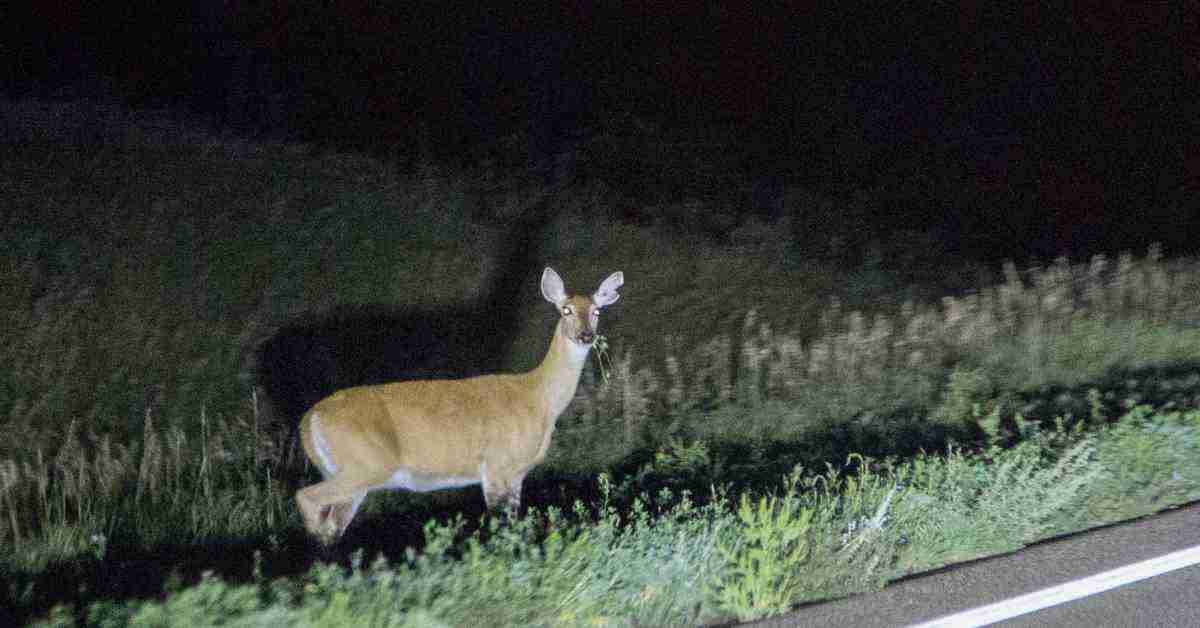If you’re new to deer hunting, then you’re probably wondering, “Are deer nocturnal?”
Well, we get you! To have proper and effective hunting strategies, every hunter must be aware of the behavioral pattern of deer. Doing so will surely enhance your hunting success.
Come along with us as we delve into the dark depths and discover the secrets of deer behavior. You’ll also learn how the time of year and type of habitat can influence their activity patterns and the adaptations they have made to survive in the wild.
Table of Contents
Understanding Deer Behavior

You may be wondering if deer are nocturnal or not. Generally speaking, deer are crepuscular animals, meaning they are most active during dawn and dusk. During the day, deer will usually find a shady spot to bed down and remain inactive until the evening.
At night, they tend to be more active and will often move around more than during the day. By understanding deer behavior patterns during different times of the day, you can plan your hunting trips accordingly and increase your chances of a successful hunt.
Deer During Different Times of the Day
Understanding deer behavior during different times of the day is like a game of chess: you must plan your moves strategically.
To increase your chances of having a successful hunt, you must understand deer behavior during the different times and plan accordingly:
- Take advantage of morning and evening feeding times
- Be aware of increased movement during twilight
- Prepare for nocturnal activity
- Scout the area to identify bedding areas
- Use calls and scents to attract deer during the day and night
The Nocturnal Nature of Deer
Have you ever wondered why deer are so difficult to hunt? It might be because of their nocturnal behavior. Nocturnal animals are active primarily at night and sleep during the day.
This means that deer are most active during low-light conditions, such as dawn and dusk. However, deer aren’t strictly nocturnal, as they can also be active during the day.
It’s important to understand their behavior to plan an effective hunting trip.
What Does Nocturnal Mean to Animals
Animals that are nocturnal are active during the night and sleep during the day, so hunters need to plan their hunts accordingly. Nocturnal behavior is widespread in the animal kingdom and can be seen in species ranging from small mammals like mice to larger predators like lions.
Nocturnal behavior has several advantages, including increased safety from predators, reduced competition for resources, and improved access to food.
In addition, nocturnal animals have evolved several adaptations to enhance their ability to navigate in the dark. These include larger eyes, more sensitive hearing, and an improved sense of smell.
They also have a heightened ability to detect movement, enabling them to spot and capture prey more easily.
Overall, understanding the nocturnal behavior of animals can help hunters better plan their hunts and increase their chances of success. Additionally, it can provide insight into the strategies animals use to survive in the wild.
Are Deer Stricly Noctural?
Although deer may be more active at night, they’re not always strictly nocturnal. Sometimes they’ll brave the light of day, especially in areas where they feel safe from hunters’ presence. It proves that, where there’s a will, there’s a way.
| Daytime | Nighttime | |
| Feeding | No | Yes |
| Traveling | No | Yes |
Deer may be active during the day in areas where they feel secure and spend their time feeding, traveling, and resting. At night, they’ll hide from potential predators and focus on feeding and traveling.
But remember, they’ll stay on alert regardless of the time of day.
Exploring Deer Activity Patterns

Every hunter needs to understand the activity patterns of deer to plan their hunt effectively. During daylight hours, deer are mainly diurnal, meaning they’ll be active during the day.
Knowing their activity patterns can help you plan your hunt and increase your chances of success.
Diurnal behavior: Deer during daylight hours
Hunting deer during the day can be a great way to increase your chances of success. Deer have diurnal behavior patterns that can be tracked and used to your advantage.
Scout their feeding areas, bedding locations, and travel routes in daylight hours to identify where deer may be. Knowing their feeding and grooming habits can help you decide where to set up your stands or blinds.
Use this knowledge to plan your hunting trips effectively and put yourself in the best position for success. Knowing the behavior patterns of deer is key to a successful hunt.
Be sure to keep your eyes open and take in the wilderness around you.
Crepuscular behavior: Deer during twilight hours
Crepuscular behavior, or activity during twilight hours, is an important factor for hunters to consider when planning a successful hunt.
Up to 70% of white-tailed deer’s movements take place during these periods. This is when deer shift between their bedding and feeding areas, which provides optimal hunting opportunities.
Hunters can capitalize on these times by setting up along travel corridors or near food sources. It’s also important to note that deer may also move during the day, especially during cool, cloudy, rainy, or windy weather.
It’s essential for hunters to be aware of these conditions so they can adjust their strategy accordingly.
Nocturnal behavior: Deer during nighttime
To understand the nighttime behavior of deer, hunters must consider a few key factors such as:
Hunting Pressure:
- The amount of hunting pressure in the area can affect deer’s nocturnal activity. Areas with high levels of hunting pressure will cause deer to be more active during the night.
- Deer will often move to areas with lower hunting pressure during the night in order to avoid hunters.
Moon Phase:
- The different phases of the moon also influence deer activity. During a full moon, deer will be more active as they can use the moonlight to navigate.
- Deer tend to be less active during a new moon phase, as the darkness makes it difficult for them to move around.
Weather Conditions:
- Deer are also affected by weather conditions. During cold, wet weather, deer will often seek shelter in thick cover and become less active.
- During warmer, drier weather, deer will be more active at night as they search for food and water.
By understanding these factors, hunters can better plan their hunts and increase their chances of success.
Adaptations of Deer for Nocturnal Behavior

You may already be aware that deer are nocturnal creatures, but did you know that this adaptation is supported by specific senses and physical characteristics?
Deer have developed specialized senses, such as large eyes and ears, and a keen sense of smell, which help them detect predators and prey in low-light conditions.
Additionally, their long legs and light bodies give them the agility and speed needed for nocturnal foraging.
Specialized senses aiding the nocturnal activity
The deer’s specialized senses, such as their sharp vision, keen hearing, and powerful sense of smell, allow them to thrive nocturnally in the wilderness. These features offer the deer an advantage when it comes to navigating the dark and avoiding predators.
- With their heightened vision, deer can spot potential threats from further away in the dark than during the day.
- Their ears can pick up even the faintest of noises, alerting them to predators or other disturbances.
- Deer also have a keen sense of smell which helps them detect food sources or other dangers.
These adaptations make deer perfectly suited for nocturnal activity, allowing them to take full advantage of their freedom, even in the dark.
Physical adaptations supporting nocturnal behavior
Discovering the physical adaptations that help deer thrive nocturnally can be a thrilling journey for any hunter.
- Camouflage is a key adaptation, enabling deer to blend into their environment and remain undetected.
- Their bodies are designed for silent movement, allowing them to move quickly and quietly to avoid predators.
- The special padding on their hooves also absorbs sound, allowing them to move in stealth.
- Their eyes are designed for low-light conditions, allowing them to see in the dark, and their ears are sensitive to even the faintest sound.
All of these adaptations give deer the advantage of being able to move around in the forest undetected and successfully forage for food without being discovered.
Conclusion
All in all, asking, “Are deer nocturnal?” can really confuse even deer enthusiasts and hunters. Although they are nocturnal, these majestic species are also active during different times fo the day.
They often hide during the day and become active at night to escape the heat and mosquitoes in the summer and to feed and migrate in the fall and winter.
- Gun Ranges For Beginners - January 25, 2024
- How To Build Indoor Gun Range: Your Ultimate Blueprint - January 25, 2024
- How To Find the Cheap Shooting Range Near Me? - January 25, 2024

